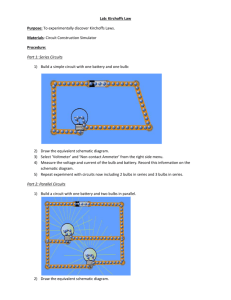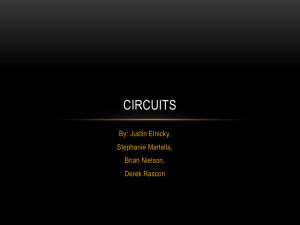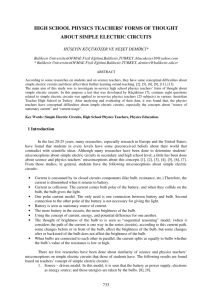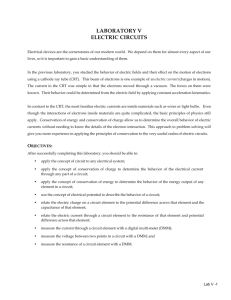docx - STAO
advertisement
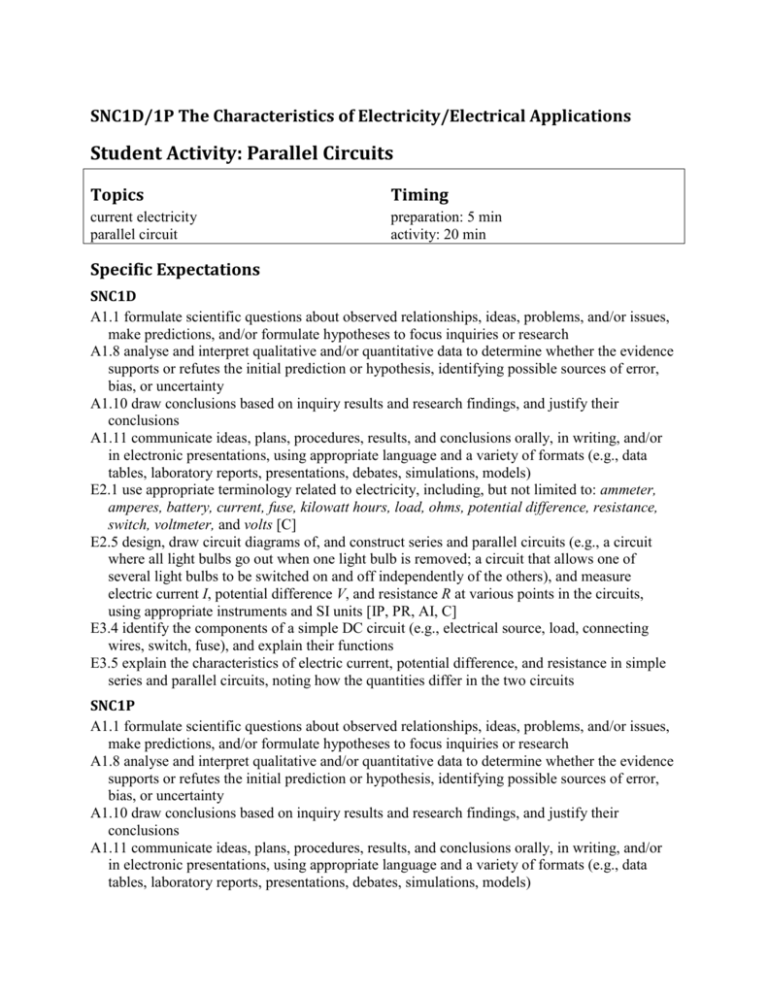
SNC1D/1P The Characteristics of Electricity/Electrical Applications Student Activity: Parallel Circuits Topics Timing current electricity parallel circuit preparation: 5 min activity: 20 min Specific Expectations SNC1D A1.1 formulate scientific questions about observed relationships, ideas, problems, and/or issues, make predictions, and/or formulate hypotheses to focus inquiries or research A1.8 analyse and interpret qualitative and/or quantitative data to determine whether the evidence supports or refutes the initial prediction or hypothesis, identifying possible sources of error, bias, or uncertainty A1.10 draw conclusions based on inquiry results and research findings, and justify their conclusions A1.11 communicate ideas, plans, procedures, results, and conclusions orally, in writing, and/or in electronic presentations, using appropriate language and a variety of formats (e.g., data tables, laboratory reports, presentations, debates, simulations, models) E2.1 use appropriate terminology related to electricity, including, but not limited to: ammeter, amperes, battery, current, fuse, kilowatt hours, load, ohms, potential difference, resistance, switch, voltmeter, and volts [C] E2.5 design, draw circuit diagrams of, and construct series and parallel circuits (e.g., a circuit where all light bulbs go out when one light bulb is removed; a circuit that allows one of several light bulbs to be switched on and off independently of the others), and measure electric current I, potential difference V, and resistance R at various points in the circuits, using appropriate instruments and SI units [IP, PR, AI, C] E3.4 identify the components of a simple DC circuit (e.g., electrical source, load, connecting wires, switch, fuse), and explain their functions E3.5 explain the characteristics of electric current, potential difference, and resistance in simple series and parallel circuits, noting how the quantities differ in the two circuits SNC1P A1.1 formulate scientific questions about observed relationships, ideas, problems, and/or issues, make predictions, and/or formulate hypotheses to focus inquiries or research A1.8 analyse and interpret qualitative and/or quantitative data to determine whether the evidence supports or refutes the initial prediction or hypothesis, identifying possible sources of error, bias, or uncertainty A1.10 draw conclusions based on inquiry results and research findings, and justify their conclusions A1.11 communicate ideas, plans, procedures, results, and conclusions orally, in writing, and/or in electronic presentations, using appropriate language and a variety of formats (e.g., data tables, laboratory reports, presentations, debates, simulations, models) E2.1 use appropriate terminology related to static and current electricity, including, but not limited to: ammeter, ampere, battery, conductivity, current, energy consumption, fuse, kilowatt hours, load, ohm, potential difference, resistance, switch, voltmeter, and volts [C] E2.4 design, draw circuit diagrams of, and construct simple series and parallel circuits (e.g., circuits with: one light bulb; two light bulbs of the same brightness; one light bulb on and the other light bulb off) [IP, PR, C] E2.5 compare, on the basis of observation, the differences between series and parallel circuits [PR, AI] E3.3 identify the components of a simple direct current (DC) electrical circuit (e.g., electrical source, electrical load, switch, fuse), and describe their functions E3.5 explain the characteristics of electric current, potential difference, and resistance, in simple series and parallel circuits Introduction In this demo, two circuits are constructed to enable comparison of the brightness of a light bulb placed in a circuit with one cell and the brightness of the same light bulb in a circuit with three cells connected in parallel. In Next Steps the potential differences of the two circuits are also compared. Materials Each group of students will need: 7 wires with alligator clips 3 cells (AA batteries) light bulb; minimum 4.5 V switch Safety Considerations Light bulbs may become hot if left on for extended periods. Beware of burns. Allow the bulbs to cool before handling them. Procedure Part One - Circuit with one cell 1. Have students make a simple circuit by connecting a cell, a switch, and a light bulb with wires (Fig. 1). Fig.1 Set-up for Step 1 with one cell 2. Observe Have students observe the brightness of the light bulb. Part Two - Circuit with three cells in parallel 3. Have students add two more cells to their circuit. The cells should be added in parallel as shown in Fig. 2, but ask students not to close the switch just yet. Fig.2 Set-up for Step 3 with three cells in parallel 4. 5. 6. 7. Predict Ask students to predict how the brightness of the bulb in the two circuits will compare. Explain Ask students to justify their predictions based on their knowledge of current electricity and the components of simple electrical circuits. Observe Have students make the final connection in the circuit to test their prediction. Explain Ask the students to review their predictions and see if they match what they have observed. Disposal Dispose of discharged cells by recycling them at a battery-recycling station in your school or in many home improvement stores (e.g., Home Depot, Canadian Tire). Have a disposal plan for broken light bulbs that is consistent with school board protocol and appropriate for your municipality. What happens? The brightness of the bulb is the same for both the circuit with one cell and the circuit with three cells connected in parallel. The two additional cells connected in parallel have no impact on the brightness of the bulb. How does it work? When cells are connected in parallel, the total potential difference across the cells is the same as the potential difference across one individual cell (if the cells are identical). For example, if using fully charged AA cells, each will have a potential difference of 1.5 V. If connecting three of these in parallel, the total potential difference across the cells is also 1.5 V. A water column analogy (see Additional Resources) is useful to model the potential difference in electrical circuits. Consider a water column with an opening at its base where water can flow out. The difference in gravitational potential energy between the top and bottom of the column depends on the height of the column. Similarly, the difference in electrical potential energy of a cell depends on the “height” or difference in electrical potential energy between the positive and negative compartments of the cell. These differences are a result of the chemical reaction that occurs in each compartment. When cells are arranged in parallel, their total “height” remains the same. Hence, the potential difference across the cells is the same as the potential difference across a single cell. Teaching Suggestions/Hints 1. 2. Check all cells prior to the activity to ensure that their potential difference is almost identical. It may be helpful to perform the water column analogy as a demo to assist students in understanding a circuit with its cells in parallel. Next Steps Repeat the activity using a voltmeter to measure the potential difference across the cells and across the light bulb (load) three cells connected in series Additional Resources 1. 2. 3. A circuit-building interactive website http://resources.schoolscience.co.uk/britishenergy/11-14/chal1.html STAO resource: a lesson on cells and batteries sources in series and parallel http://stao.ca/res2/elw/L41.php STAO resource: water column analogy http://stao.ca/VLresources/2008/TheWaterModel.doc




